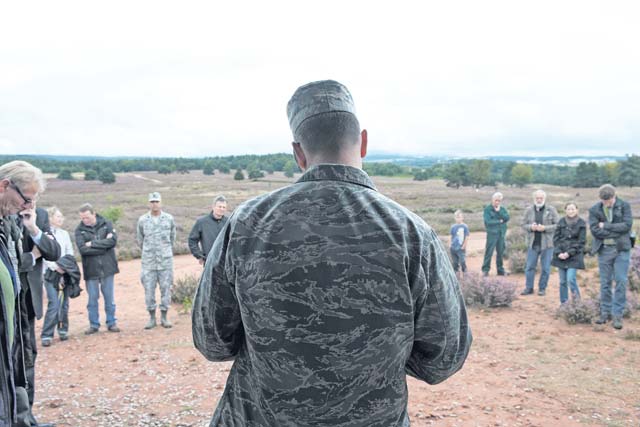
Ramstein and its host nation partners gathered Aug. 27, to celebrate 10 years of preserving approximately 86 acres of forgery and wild life in part of the Mehlinger Heide foundation.
According to Brig. Gen. Patrick X. Mordente, 86th Airlift Wing commander, the Mehlinger Heide conservation effort exemplifies civilian and military cooperation to preserve natural surroundings, and demonstrates that the military can be a good steward of the environment while accomplishing its mission.
The Mehlinger Heide foundation started as an idea in 2004 to address compensation measures required by German laws that demands that for each impacted habitat or sealed surface used by Ramstein, another habitat of the same type and size must be created near the area where the former habitat was developed inside the installation.
“Any time an area is converted for a different use to fulfill our mission, we’re required to compensate for the impact on the undeveloped natural structure,” Mordente said. “But due to limited installation size, it’s just a matter of time before we run out of compensation space within our installation. Therefore, the alternative concept which we know today as the Mehlinger Heide foundation was initiated.”’
The idea was to find substitute space outside the installation while staying compliant with the compensation requirements, as well as funds for upkeep of Mehlinger Heide.
“The Foundation Mehlinger Heide takes care of the maintenance and development of the third largest European dry heath habitat type in southern Germany,” said Joern Jeblick, 86th Civil Engineering Squadron chief environmental biologist. “The money for the different maintenance measures like mowing, bush removal and grazing with sheep and goats comes from environmental compensation measures for construction projects on Ramstein.”
The land preserved by the Mehlinger Heide foundation also provides a mulch material that is used to deter birds by the Ramstein runways, creating a safer environment for the aircraft and pilots that transit through every day.
“There is one more benefit from the Mehlinger Heide. A good part of it can be found on the Ramstein airfield,” Mordente said. “In 2008, we used heather seeds and mulch from the Mehlinger Heide to develop more than 17 acres of European dry heather habitat in the infield between the two runways. We not only created a valuable habitat, this also helps us increase our flight safety. It keeps birds away from the airfield since they don’t like that kind of ground covering and avoid these areas.”
The Mehlinger Heide foundation is a project that brought civilian and military partners together and continues to aid the Air Force in countless operational missions while simultaneously preserving an ecosystem within Germany.
“This is a triple-win situation,” Jeblick said. “Ramstein gets rid of the necessity to sacrifice its land for compensation measures, which might impede the base development, the third largest heather area in southern Germany is preserved and even improved for the next 50 years, which is paid by the interest derived from the foundation capital and of course, the German public has a wonderful recreation area.”
It is through this common ground Ramstein and Germany were able to grow another flourishing partnership, not only aiding in countless operations, but helping protect wildlife and the environment.


